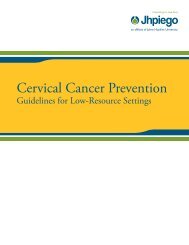Manual for Male Circumcision under Local Anaesthesia
Manual for Male Circumcision under Local Anaesthesia
Manual for Male Circumcision under Local Anaesthesia
You also want an ePaper? Increase the reach of your titles
YUMPU automatically turns print PDFs into web optimized ePapers that Google loves.
<strong>Male</strong> circumcision <strong>under</strong> local anaesthesia<br />
Version 3.1 (Dec09)<br />
standard precautions to avoid infection with HIV and other<br />
organisms, and to avoid passing such infections from one<br />
patient to another. Men who are found to be infected with HIV<br />
can safely have a circumcision procedure, provided they are<br />
clinically healthy, but there is no point in having a circumcision<br />
to reduce the risk of acquiring or transmitting HIV infection. It is<br />
most important that men with HIV infection take steps to<br />
reduce the likelihood of transmitting the virus to others by<br />
avoiding penetrative sexual intercourse or always using<br />
condoms.<br />
The circumcision team should ensure that the client has been<br />
in<strong>for</strong>med about the risks and benefits of male circumcision as<br />
described in Chapter 3. This in<strong>for</strong>mation should be given in an<br />
<strong>under</strong>standable way, using everyday local language. The oral<br />
in<strong>for</strong>mation should be backed up by written in<strong>for</strong>mation sheets<br />
in the local language. After receiving the in<strong>for</strong>mation the client<br />
should be allowed to ask questions. He should then be given<br />
time to reflect be<strong>for</strong>e being asked to sign the certificate of<br />
consent. An example in<strong>for</strong>mation sheet and consent certificate<br />
can be found in the appendices to Chapter 3.<br />
PREOPERATIVE WASHING BY THE PATIENT<br />
On the day of surgery, the client should wash his genital area<br />
and penis with water and soap, retracting the <strong>for</strong>eskin and<br />
washing <strong>under</strong> it. This ensures that the genital area is clean<br />
be<strong>for</strong>e he comes to the clinic. Immediately be<strong>for</strong>e the<br />
operation, the skin should be further cleaned with povidone<br />
iodine (see Chapter 5).<br />
If the pubic hair is long and likely to get in the way of surgery or<br />
interfere with the dressing, it should be clipped be<strong>for</strong>e the<br />
patient enters the operating room. The patient can do this at<br />
home on the day of surgery, or it can be done at the clinic.<br />
Shaving is not necessary.<br />
The patient should be given the opportunity to empty his<br />
bladder be<strong>for</strong>e going into the operating room.<br />
SCRUBBING AND PUTTING ON PROTECTIVE CLOTHING<br />
Be<strong>for</strong>e entering the operating room area, all members of the<br />
surgical team should:<br />
• Remove all jewellery and ensure nails are trimmed or filed.<br />
• Remove any artificial nails or nail polish.<br />
• Wash hands and arms up to the elbow with a nonmedicated<br />
soap.<br />
• Make sure hands and nails are not visibly soiled.<br />
Be<strong>for</strong>e the circumcision operation, anyone who will touch the<br />
sterile surgical field, the surgical instruments or the wound<br />
Facilities and supplies and preparation <strong>for</strong> surgery Chapter 4-7
















